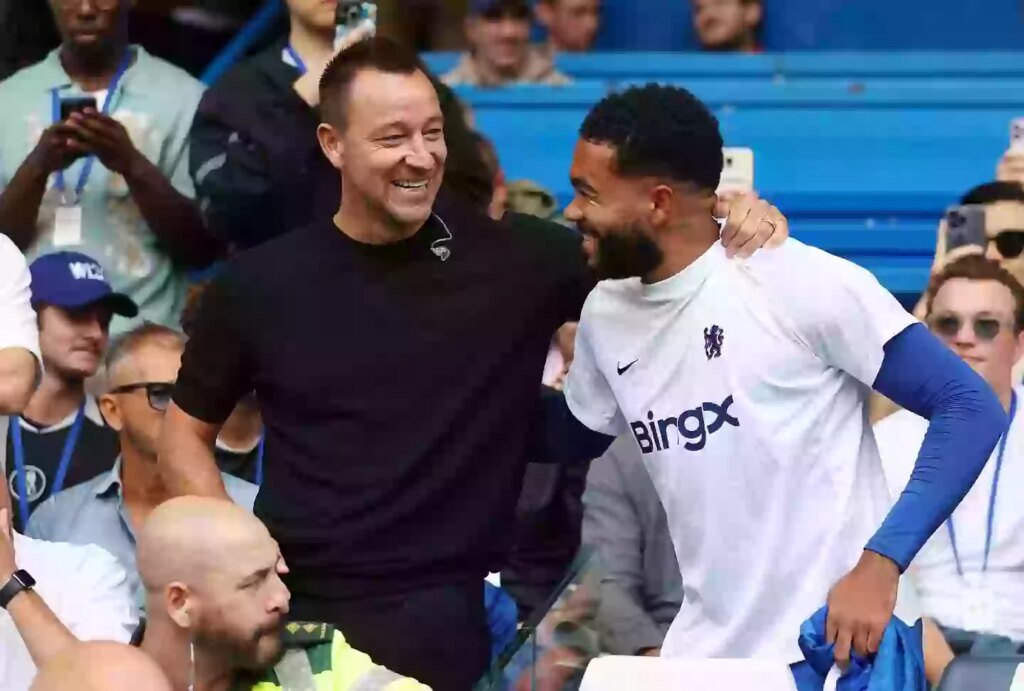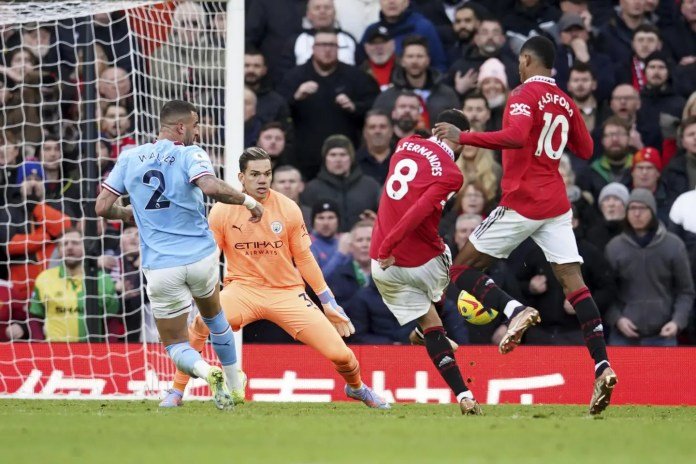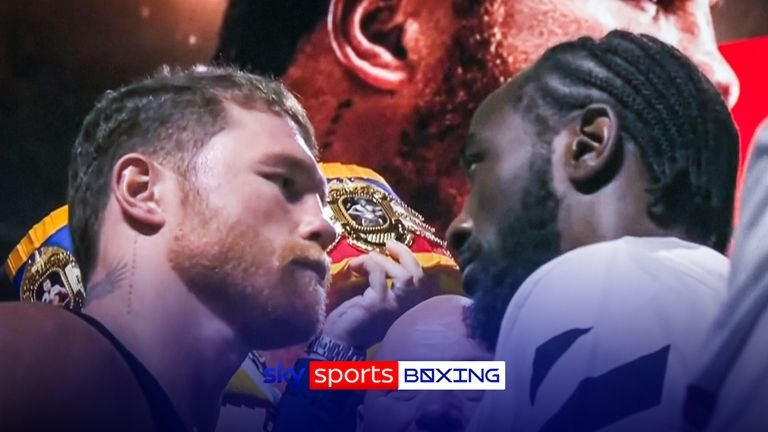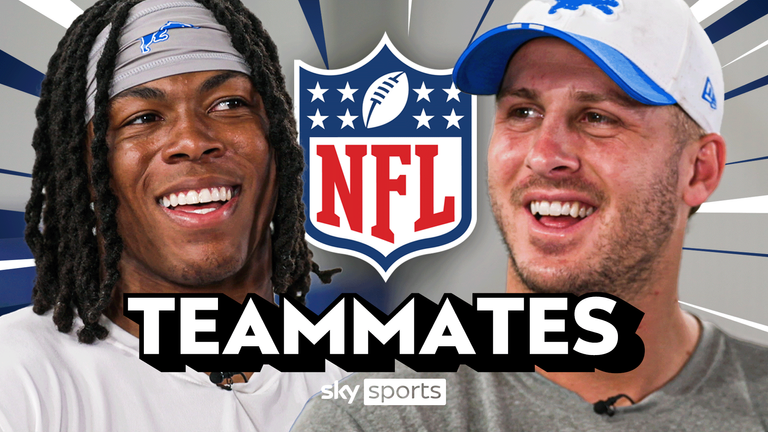Three rounds of fixtures down, 35 to go.
The Premier League returns for round four after the first international break of the season, so the timing is right to reflect on the opening weeks.
Defending champions Liverpool are the only side to take maximum points, Manchester United are enjoying the rarity of being above their city neighbours, and only three teams (Crystal Palace, Chelsea and Liverpool) are yet to taste defeat, the fewest after three matches since four sides in the late-starting 2020-21 campaign.
Ahead of the league’s resumption, let’s open the tactical notebook.

Pep Guardiola contemplates his side’s defeat in East Sussex (Justin Setterfield/Getty Images)
Manchester City’s high press problems
Twice already this season, opponents have found the breaking point in Manchester City’s press and scored as a result.
Brighton & Hove Albion’s 89th-minute winner at the Amex Stadium in matchweek three came about in a near-identical manner to Tottenham Hotspur’s opener against City a week earlier — even though the moves were down opposite sides of the pitch.
City started in a narrow 4-3-3 pressing scheme, with the wingers tucked in to prevent central passes and ready to sprint wide to Brighton’s full-backs.
Oscar Bobb is a little slow to get out towards Maxim De Cuyper when Brighton build out down their left (City’s right).
Right-back Rico Lewis has jumped, meaning he and Tijjani Reijnders are focused on Yasin Ayari. This leaves three City defenders stretched across the halfway line. De Cuyper goes long.

If the first contact was a big, looping header back upfield, into touch, or to a team-mate, City would have been fine. However, John Stones heads it straight at Ayari, and neither Lewis nor Reijnders is positioned to duel.
The Sweden international heads forward to Georginio Rutter, and the problem appears. City are overloaded four-v-three on the last line.
Stones, having pulled wide to cover for Lewis, has isolated Ruben Dias one-v-two against Rutter and (eventual goalscorer) Brajan Gruda.

Rayan Ait-Nouri — signed as a wing-back from Wolverhampton Wanderers this summer — needs to get in more to support Dias, but is mindful about leaving Yankuba Minteh in too much space on the far side.
Brighton lock-pick City with two passes. First, Rutter sets the ball to Kaoru Mitoma. Stones is marking the Japan international and ends up out of position when he goes wide to defend the long ball.
Then Mitoma releases Gruda, who runs through, chops back onto his right foot to sit Ait-Nouri and James Trafford down, and slots into an empty net.

“It’s tiredness,” explained Guardiola in his post-match press conference. “We attacked in the moment and pressed really well. The clearance was short, we didn’t close the gap on the side, and they had fast players.”
He has praised his team for their “really good high pressing, in general,” but Thomas Frank’s Tottenham set up their Etihad win with a goal from a long ball against the press.
There, again, the winger was too passive in closing down the opposition full-back, who played a ball in-behind.
It was left back Nathan Ake who stepped forward that time, and the offside trap was beaten when Pape Matar Sarr flicked Pedro Porro’s long ball forward and Richarlison raced through. His second touch was a low cross for Brennan Johnson, who scored a trademark back-post tap-in.
In the finest of margins, Brennan Johnson gives Spurs the lead over City following a VAR review!
📺 @tntsports & @discoveryplusUK pic.twitter.com/FgMaK1POoq
— Football on TNT Sports (@footballontnt) August 23, 2025
This is a continuation of the out-of-possession problems that plagued City last season, when they were particularly bad in duels, committed numbers to press without enough intensity, and midfielders reacted too slowly to land on second balls.
It’s certainly something to keep an eye on during Sunday’s Manchester derby at the Etihad.
Chelsea keep scoring from inswinging corners
Enzo Maresca’s side only scored seven times from corners last season, but they are already more than halfway to matching that in 2025-26, with four corner goals in just three matches.
Bernardo Cueva, the set-piece coach who moved across west London from Brentford to Chelsea in the summer of 2024, is beginning to make his mark.
He has found plenty of success with inswinging deliveries — via the left-footed Pedro Neto from the right, and Enzo Fernandez with right-footed curlers on the other side.
They threatened twice with corners at the end of the first half against Fulham, once from each side. Then, in the ninth minute of first-half stoppage time, Fernandez dropped one on the money for Joao Pedro in the six-yard box.
Seventeen of Chelsea’s 22 corners this season have been inswingers, following a Premier League-wide trend that has been to weaponise blocking and pack bodies close to goal before whipping balls on top of the opposition goalkeeper.
It is a strategic change from last season, when Chelsea played the third-most short corners in the Premier League, and they continued with those as their primary delivery method during the victorious Club World Cup tournament this summer.

Chelsea netted three times from corners in a 5-1 demolition of West Ham United in matchweek two, only the seventh instance a Premier League side managed that in one match since the start of 2018-19.
Marc Cucurella has played a key role with near-post flick-ons and nodded on Fernandez’s inswinger to set up Joao Pedro’s headed opener in the West Ham win.
Moises Caicedo and Trevoh Chalobah netted Chelsea’s fourth and fifth in east London, pouncing after goalkeeper Mads Hermansen flapped alarmingly at the inswingers.
Promoted teams playing promoted team football
It took until matchday 11 last season for all three promoted teams to win a game. The consensus in recent years is that too many clubs coming up from the Championship have tried to compete with utopian, possession-based attacking football and failed spectacularly.
In 2023-24 and 2024-25, all three promoted teams went down, with the two weakest combined points totals (66 and 59, respectively) in the competition’s history.
But things have started better for Burnley, Sunderland and Leeds United. This season is the first since 2016-17 that the promoted trio all tasted victory in the first two matchdays.
Perhaps it is because all three — coached by Scott Parker, Regis Le Bris and Daniel Farke — have been relegated from one of Europe’s top-five leagues before. Their teams are leaning into more traditional ways of playing by underdog teams.
Burnley, who built their 100-point campaign last year on clean sheets, started this season playing a 5-4-1 away at Tottenham. Parker has since reverted to 4-2-3-1, but is not as inflexible as other young English head coaches.
Their second equaliser away at Manchester United (in a match they lost by conceding a stoppage-time penalty) came from a long throw and a scramble in the box.
Sunderland have been particularly threatening from wide areas, creating their first two goals from crosses in the opening-round 3-0 win at home to West Ham.


Most recently, Wilson Isidor headed in a 96th-minute winner against Brentford.
“I think the first half was positive, we controlled this part of the game without creating many chances or scoring — it was the main regret,” Le Bris said. ”The second half was totally different. More chaotic, more open. We know that, in the Premier League, some games will be completely open and the way we managed this part was positive.”

Leeds, for comparison, recovered from a 5-0 battering away at Arsenal to draw against Newcastle United in matchweek three, recording a second clean sheet of the season, after a 1-0 win over Everton on matchday one. They are the first promoted team to keep clean sheets in their first two home matches of a season since Huddersfield Town in 2017-18.
“We showed a good physical performance,” Farke said of the goalless match with Newcastle. “It is not like the Championship, so playing against bigger sides, you have to adapt to what is needed.“
With height and physicality being a theme of Leeds’ summer recruitment, their build-up has been more direct. Lucas Perri launched all nine of his goal-kicks and 28 of his 35 open-play passes at home to Newcastle.

The three newcomers may not win many style points this season, but if they all stay up, they won’t care in the slightest.
Grealish is thriving in the left half-space
No longer standing out on the touchline, dribbling towards his own goal and playing risk-averse passes, Jack Grealish is thriving at Everton, following a loan move from Manchester City.
David Moyes has restructured their attack, playing Grealish off the left in a 4-2-3-1. Dominic Calvert-Lewin, once their talisman, was let go on a free, with summer-signing Thierno Barry and Beto providing the focal point.

Grealish and Everton have started the season well (Clive Mason/Getty Images)
Iliman Ndiaye has switched flanks to the right side, to make space for Grealish, while Kiernan Dewsbury-Hall has added quality and beyond-the-ball running from his No 10 position.
Everton, while effective from set pieces and deep crosses in recent years, have sorely lacked a standout creator — particularly players with the talent to find incisive passes in the half-spaces.
Grealish attempted 10 take-ons in the 3-2 win away at Wolves, his most in a match since April 2022 (which was the only time he hit double digits in a league game for City).
His creativity from the left half-space was outstanding and contributed to all three Everton goals. Beto broke the deadlock following a sequence where Everton were recycling possession on the edge of the box for more than 30 seconds, after a corner had been cleared.
Grealish, positioned on Marshall Munetsi’s blindside, timed his run to meet Vitalii Mykolenko’s chipped pass in-behind.

He headed across goal, picking Beto out to finish from three yards.

The pick of the bunch was Grealish’s reverse pass in the build-up to their second goal, as he held off Wolves midfielder Andre and slipped Dewsbury-Hall through — another back-post tap-in, this time for Ndiaye.
Grealish provided Dewsbury-Hall with a through ball for what became the match-winner in the second half. He completed three through balls that match, his most in any Premier League game.

Four assists already means he tops the yes-very-early assist charts. More importantly, the England international has created twice as many goals as in his previous two Premier League seasons, and all for different team-mates.
“He’s even better than I thought he was,” head coach David Moyes said of Grealish after the Wolves win.
His individual brilliance was best shown for the opening goal at home against Brighton. A high-and-wide Grealish is found early, with Idrissa Gueye and Dewsbury-Hall becoming the link players.

Grealish dribbles straight to the box. Ndiaye and Beto make smart opposite movements at the far post, with Beto attacking between the centre-backs. Meanwhile, Ndiaye ghosts behind left-back De Cuyper.
Brighton have doubled up on Grealish, who slows down before speeding away outside Mats Wieffer.

He crosses low and early with his left foot, giving Ndiaye a tap-in.

This creative boost is a much-needed one for Everton. Their top assisters in recent years have been Dwight McNeil, who set up six goals in 2023-24 and the same number last term. Before that, it was Alex Iwobi with seven in 2022-23.
In a landmark season for the club, only two teams (Liverpool and Chelsea) have picked up more points than Everton in the opening three weeks. It’s an extremely solid foundation for David Moyes to build on.







